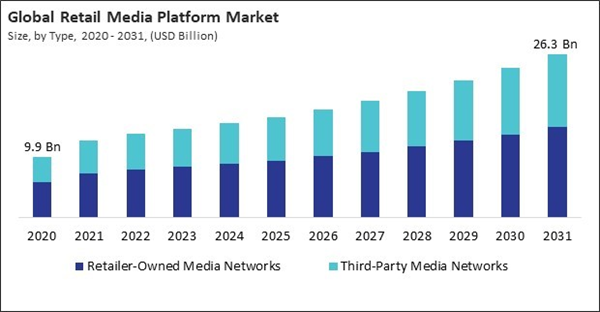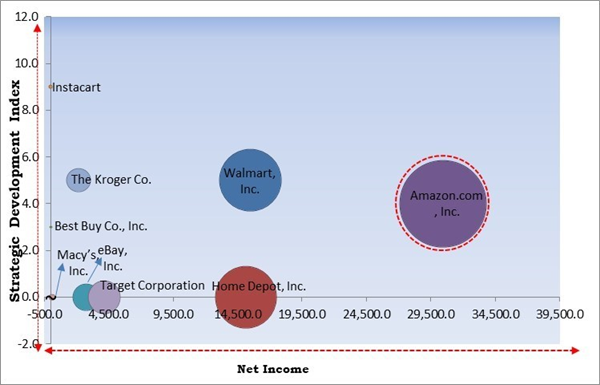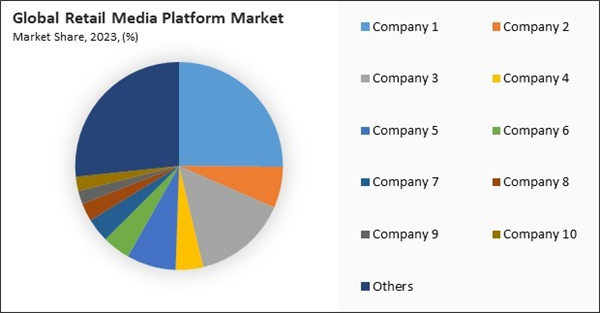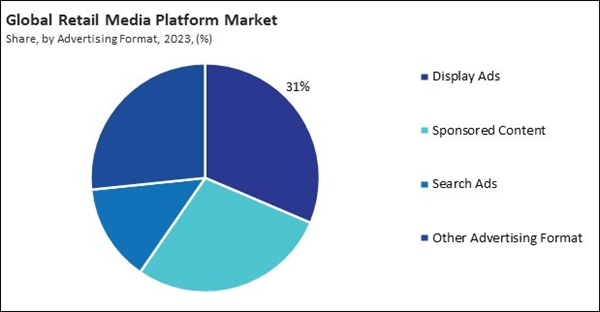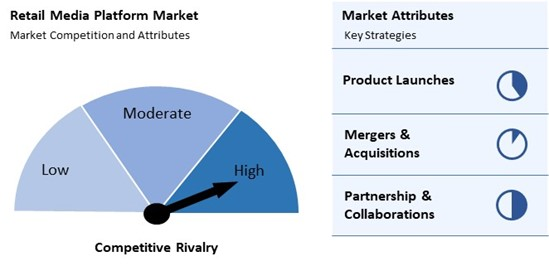The Global Retail Media Platform Market size is expected to reach $26.3 billion by 2031, rising at a market growth of 8.2% CAGR during the forecast period.
Beauty and personal care brands have increasingly turned to retail media platforms to promote their products, leveraging the visual appeal and storytelling potential of these platforms to engage customers. Hence, the beauty & personal care segment garnered 20% revenue share in the market in 2023. Beauty brands are in a favorable position to capitalize on retail media that provides targeted and visually appealing ad formats, including shoppable content and video, as a result of the increasing prevalence of influencer marketing and social media integration. The ability to reach consumers at various stages of their shopping journey, both online and in-store, allows beauty and personal care brands to create personalized experiences that resonate with customers, contributing to the growth of this segment in the retail media platform market.
The major strategies followed by the market participants are Partnerships as the key developmental strategy to keep pace with the changing demands of end users. For instance, In May, 2024, Kroger collaborated with Yahoo, a global leader in internet services, to expand the reach of Kroger’s retail media network. This collaboration allows Yahoo to tap into Kroger’s first-party shopper data, enabling more precise ad targeting across Yahoo’s digital properties. Additionally, In May, 2024, Instacart formed a partnership with ROFDA, a cooperative representing independent grocers across the United States, to power the retail media network for ROFDA’s independent grocer members. Through this collaboration, Instacart will provide its retail media expertise, enabling ROFDA members to offer enhanced digital advertising opportunities to brands.
Another aspect contributing to the rise in digital advertising budgets is the transparency and accountability digital channels offer compared to traditional advertising methods. In the digital space, brands have access to detailed metrics, such as impressions, clicks, and conversion rates, which help them evaluate the effectiveness of their campaigns. This level of visibility encourages brands to invest more in digital advertising, as they can better track and optimize their campaigns for improved performance. This shift has positioned retail media platforms as an essential channel for brands seeking a clear return on investment. Thus, the increase in digital advertising budgets drives the market's growth.
The leading players in the market are competing with diverse innovative offerings to remain competitive in the market. The above illustration shows the percentage of revenue shared by some of the leading companies in the market. The leading players of the market are adopting various strategies in order to cater demand coming from the different industries. The key developmental strategies in the market are Partnerships & Collaborations.
The competition in the Retail Media Platform Market is intense, characterized by numerous players vying for market share. Companies leverage data analytics, targeted advertising, and enhanced customer engagement strategies to differentiate themselves. The increasing emphasis on personalized marketing and the integration of advanced technologies, such as artificial intelligence, further intensify the rivalry. Additionally, the growing shift towards digital shopping experiences compels participants to innovate continuously, ensuring they meet the evolving needs of advertisers and consumers alike.
Beauty and personal care brands have increasingly turned to retail media platforms to promote their products, leveraging the visual appeal and storytelling potential of these platforms to engage customers. Hence, the beauty & personal care segment garnered 20% revenue share in the market in 2023. Beauty brands are in a favorable position to capitalize on retail media that provides targeted and visually appealing ad formats, including shoppable content and video, as a result of the increasing prevalence of influencer marketing and social media integration. The ability to reach consumers at various stages of their shopping journey, both online and in-store, allows beauty and personal care brands to create personalized experiences that resonate with customers, contributing to the growth of this segment in the retail media platform market.
The major strategies followed by the market participants are Partnerships as the key developmental strategy to keep pace with the changing demands of end users. For instance, In May, 2024, Kroger collaborated with Yahoo, a global leader in internet services, to expand the reach of Kroger’s retail media network. This collaboration allows Yahoo to tap into Kroger’s first-party shopper data, enabling more precise ad targeting across Yahoo’s digital properties. Additionally, In May, 2024, Instacart formed a partnership with ROFDA, a cooperative representing independent grocers across the United States, to power the retail media network for ROFDA’s independent grocer members. Through this collaboration, Instacart will provide its retail media expertise, enabling ROFDA members to offer enhanced digital advertising opportunities to brands.
KBV Cardinal Matrix - Market Competition Analysis
Based on the Analysis presented in the KBV Cardinal matrix; Amazon.com, Inc. is the forerunner in the Retail Media Platform Market. Companies such as Walmart, Inc., Home Depot, Inc., and The Kroger Co. are some of the key innovators in Retail Media Platform Market. In May, 2024, Walmart joined hands with Disney, a global leader in entertainment, to launch a retail media and connected TV (CTV) advertising integration. This collaboration combines Walmart's retail media expertise with Disney’s premium content, enabling brands to connect with shoppers through immersive advertising experiences.Market Growth Factors
In 2020, e-commerce accounted for 19% of global retail sales, a significant increase from 14% in 2019, as highlighted by UNCTAD. This rapid growth has prompted brands to shift their advertising budgets towards channels that offer better targeting and measurable outcomes, such as retail media platforms. By utilizing the data from e-commerce activities, these platforms enable brands to engage with shoppers meaningfully, delivering ads that resonate with their current needs and preferences. Hence, the alignment between the rise of e-commerce and the capabilities of retail media platforms has created a powerful synergy, propelling the growth of the market.Another aspect contributing to the rise in digital advertising budgets is the transparency and accountability digital channels offer compared to traditional advertising methods. In the digital space, brands have access to detailed metrics, such as impressions, clicks, and conversion rates, which help them evaluate the effectiveness of their campaigns. This level of visibility encourages brands to invest more in digital advertising, as they can better track and optimize their campaigns for improved performance. This shift has positioned retail media platforms as an essential channel for brands seeking a clear return on investment. Thus, the increase in digital advertising budgets drives the market's growth.
Market Restraining Factors
Navigating the complex and evolving regulatory environment requires retail media platforms to invest significantly in compliance infrastructure. They must employ data protection officers, invest in privacy-enhancing technologies, and establish rigorous internal protocols for data handling. This increases operational costs and requires ongoing adaptation to stay up-to-date with regulatory changes. For example, beyond the GDPR and CCPA, many other regions, such as Brazil with its LGPD (Lei Geral de Proteção de Dados) and India with its draft Personal Data Protection Bill, are introducing their versions of privacy regulations. Hence, such factors may hamper the growth of the market.The leading players in the market are competing with diverse innovative offerings to remain competitive in the market. The above illustration shows the percentage of revenue shared by some of the leading companies in the market. The leading players of the market are adopting various strategies in order to cater demand coming from the different industries. The key developmental strategies in the market are Partnerships & Collaborations.
Driving and Restraining Factors
Drivers- Rapidly Growing E-commerce Sales
- Rise in Digital Advertising Budgets
- Emergence of New Ad Formats
- Data Privacy and Regulatory Concerns
- High Competition and Fragmentation
- Shift Towards an Omnichannel Shopping Experience
- Integration with Social Media and Influencer Marketing
- Lack of Standardized Metrics for Evaluating Performance
- Integration Challenges with Legacy Systems
Type Outlook
Based on type, the market is bifurcated into retailer-owned media networks and third-party media networks. The retailer-owned media networks segment garnered 57% revenue share in the market in 2023. Retailers like Amazon, Walmart, and Target have built their advertising ecosystems, leveraging their extensive first-party data to offer brands highly targeted and effective advertising opportunities. By owning and operating these platforms, retailers generate an additional revenue stream and gain greater control over how ads are delivered, providing brands with direct access to their customers.Advertising Format Outlook
On the basis of advertising format, the market is classified into display ads, sponsored content, search ads, and others. The sponsored content segment recorded 28% revenue share in the retail media platform market in 2023. Sponsored content, often integrated seamlessly within the browsing experience, provides a more native approach to advertising. It includes product recommendations, featured listings, or branded content that aligns with the consumer's interests and is designed to blend in with the surrounding content.Industry Vertical Outlook
By industry vertical, the market is divided into consumer packaged goods (CPG), beauty & personal care, electronics & technology, apparel & fashion, grocery & food delivery, and others. The consumer packaged goods (CPG) segment witnessed 24% revenue share in the market in 2023. The CPG industry benefits significantly from retail media platforms as they offer a direct way to reach consumers at purchase. Brands within this segment leverage retail media to showcase new products, promote deals, and build brand awareness. The vast volume of products and frequent purchase cycles in the CPG sector make retail media platforms an ideal medium to engage customers effectively, resulting in substantial ad spending and revenue generation.Regional Outlook
Region-wise, the market is analyzed across North America, Europe, Asia Pacific, and LAMEA. The North America segment acquired 36% revenue share in the market in 2023. The rapid expansion of e-commerce and the presence of industry giants such as Amazon, Walmart, and Target have propelled North America, which is led by the United States, to the vanguard of retail media adoption. The advanced digital infrastructure, widespread use of first-party data for personalized advertising, and growing investment by brands in targeted online campaigns have all contributed to the strong performance of retail media platforms in this region.Market Competition and Attributes
The competition in the Retail Media Platform Market is intense, characterized by numerous players vying for market share. Companies leverage data analytics, targeted advertising, and enhanced customer engagement strategies to differentiate themselves. The increasing emphasis on personalized marketing and the integration of advanced technologies, such as artificial intelligence, further intensify the rivalry. Additionally, the growing shift towards digital shopping experiences compels participants to innovate continuously, ensuring they meet the evolving needs of advertisers and consumers alike.
Recent Strategies Deployed in the Market
- Jun-2024: Instacart unveiled extension of first-party data to YouTube to enhance its retail media offerings and allowing select brand partners to create shoppable ads. Collaborating with Clorox and Publicis Media, these ads enable consumers to click directly to Instacart for same-day delivery, utilizing closed-loop measurement for campaign effectiveness.
- Jun-2023: Kroger launched a self-service platform for its retail media network. The platform empowers advertisers to independently create and manage campaigns, utilizing Kroger’s shopper data to better connect with consumers across various digital channels.
- Apr-2023: Kroger Precision Marketing teamed up with Disney Advertising to enhance retail and CPG marketing through a beta test using retail media insights. This initiative aims to improve audience targeting and measurement, delivering tangible results for brands. Lisa Valentino emphasizes that Disney’s extensive reach and Kroger’s insights benefit both viewers and advertisers.
- Jan-2022: Best Buy Co., Inc. unveiled Best Buy Ads, an in-house media company aimed at connecting brands, agencies, and non-endemic brands with consumers through data-driven ad offerings. Leveraging 3 billion annual customer interactions, the platform emphasizes digital retail media growth and promotes inclusion and diversity in advertising.
- Sep-2021: Instacart entered into a partnership with Kroger, an American retail company. Under this partnership, the companies aimed to launch Kroger Delivery Now, a virtual convenience store that delivers meal solutions, fresh food, snacks, and other products within 30 minutes. In addition, the new service encompasses a choice of nearly 25,000 items available for 50 million households through 2,700 grocery stores of Kroger.
List of Key Companies Profiled
- Amazon.com, Inc.
- eBay, Inc.
- Walmart, Inc.
- Home Depot, Inc.
- The Kroger Co. (Kroger Precision Marketing)
- Instacart
- Target Corporation (Target Brands, Inc.)
- Macy’s, Inc.
- Best Buy Co., Inc.
- Wayfair Inc.
Market Report Segmentation
By Type- Retailer-Owned Media Networks
- Third-Party Media Networks
- Display Ads
- Sponsored Content
- Search Ads
- Other Advertising Format
- Consumer Packaged Goods (CPG)
- Beauty & Personal Care
- Electronics & Technology
- Apparel & Fashion
- Grocery & Food Delivery
- Others Industry Vertical
- North America
- US
- Canada
- Mexico
- Rest of North America
- Europe
- Germany
- UK
- France
- Russia
- Spain
- Italy
- Rest of Europe
- Asia Pacific
- China
- Japan
- India
- South Korea
- Australia
- Malaysia
- Rest of Asia Pacific
- LAMEA
- Brazil
- Argentina
- UAE
- Saudi Arabia
- South Africa
- Nigeria
- Rest of LAMEA
Table of Contents
Chapter 1. Market Scope & Methodology
Chapter 2. Market at a Glance
Chapter 3. Market Overview
Chapter 4. Competition Analysis - Global
Chapter 5. Global Retail Media Platform Market by Type
Chapter 6. Global Retail Media Platform Market by Advertising Format
Chapter 7. Global Retail Media Platform Market by Industry Vertical
Chapter 8. Global Retail Media Platform Market by Region
Chapter 9. Company Profiles
Companies Mentioned
Some of the key companies profiled in this Retail Media Platform Market include:- Amazon.com, Inc.
- eBay, Inc.
- Walmart, Inc.
- Home Depot, Inc.
- The Kroger Co. (Kroger Precision Marketing)
- Instacart
- Target Corporation (Target Brands, Inc.)
- Macy’s, Inc.
- Best Buy Co., Inc.
- Wayfair Inc.
Methodology

LOADING...



